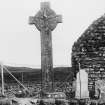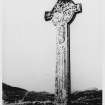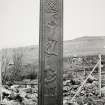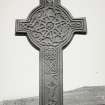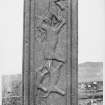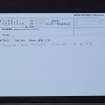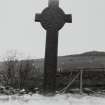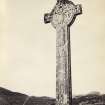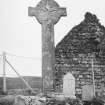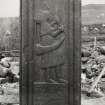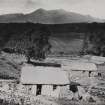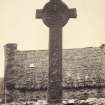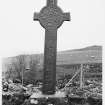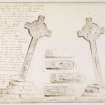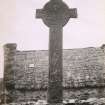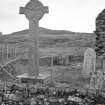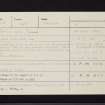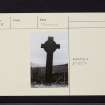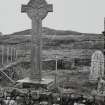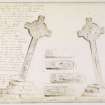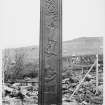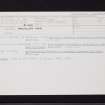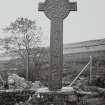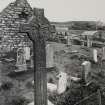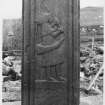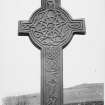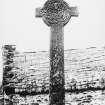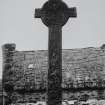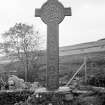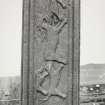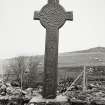Kilmory Chapel, Macmillan's Cross
Cross (Medieval)
Site Name Kilmory Chapel, Macmillan's Cross
Classification Cross (Medieval)
Alternative Name(s) St Malrhuba's Chapel
Canmore ID 39040
Site Number NR77NW 2
NGR NR 70251 75100
Datum OSGB36 - NGR
Permalink http://canmore.org.uk/site/39040
- Council Argyll And Bute
- Parish South Knapdale
- Former Region Strathclyde
- Former District Argyll And Bute
- Former County Argyll
NR77NW 2 70251 75100
(NR 7024 7510) Stone Cross (NR)
OS 6" map, Argyllshire, 2nd ed., (1900).
See also NR77NW 3.
The MacMillan Cross stands at the W of the graveyard. It is inscribed "+hec est crux Alexandri Macmulen", with a crucifixion and sword on one face, and a hunting scene on the other.
M Campbell and M Sandeman 1964
As described. A Medieval memorial cross.
Surveyed at 1:2500.
Visited by OS (DWR) 5 June 1973
No change to the report of OS (DWR).
Surveyed at 1/10,000.
Visited by OS (BS) 25 January 1977
This cross was moved inside the Chapel nearby in 1981.
Visited by OS Reviser September 1985
Field Visit (23 September 1942)
This site was included within the RCAHMS Emergency Survey (1942-3), an unpublished rescue project. Site descriptions, organised by county, vary from short notes to lengthy and full descriptions and are available to view online with contemporary sketches and photographs. The original typescripts, manuscripts, notebooks and photographs can also be consulted in the RCAHMS Search Room.
Information from RCAHMS (GFG) 10 December 2014.
External Reference (20 July 1971)
Of uncertain date, possibly c.1450 Celtic. Monolithic cross of Latin type;
upright on a stepped pedestal. E face carved with stag, huntsman etc; W face
with crucifixion sword and scroll decorations etc.
T S Muir "Old Church Architecture" p.102 S MacMillan 'Families of
Knapdale'. Grant "Lordship of the Isles" pp.345-351.
A perfect specimen of a standing cross. Erected by Alexander McMillan, 5th
of Knap.
De-scheduled 15 November 1999.
Information from Historic Scotland, 20 July 1971
Field Visit (June 1987)
(38) MACMILLAN'S CROSS. Free-standing cross, in an excellent state of preservation, which until 1981 stood in its original socket-stone (infra) at the NW angle of the churchyard. It measures 2.81m in visible height, tapers in width from 0.38m at the base to 0.36m below the cross-head, and is 0.13m thick; the disc-head has a diameter of 0.77m and the span is 1.08m, the top arm being longer and wider than the side-arms. Each face is framed by two mouldings separated by a deep channel, and the broader outer moulding has a rebated background which forms a narrow central projection on the edges.
The W face of the cross-head shows the Crucified Saviour, bearded and with an elaborately interlaced loincloth, on a plain and somewhat irregular rood. He is flanked on His right by the hooded Virgin and on His left by a bearded St John, both of whom hold books. Above the rood there are interlaced plant-stems, including a triquetra, which are linked to the tail of an animal in the left arm and to an interlaced knot on the right. Plant-stems which form pedestals for the Virgin and St John intertwine in the upperpart of the shaft, whose lower part is occupied by a large sword with lobated pommel, inclined quillons with expanded terminals, langet and an elaborate scabbard-chape. The quillons interrupt the inner moulding, and just above them there are trefoils linked to the moulding, while the sword blade is flanked on the left by a twist and on the right by a three-cord plait, which merge in a ring-knot at the foot of the shaft.
The E face of the cross-head is filled with twisted stems, without foliage except in the right arm and one other place, interlaced with a ring and enclosing a central space which contains a small leaping animal biting its own tail. In the upper part of the shaft is an interlaced cross merging into a ring-knot, of which one strand forms the tail of the uppermost hound in a deer-hunt. This shows a stag attacked by two massive hounds with collars, and a third hound, of lighter build, above. In the lower part of the shaft is the 0.47m figure of a bearded huntsman, his head turned upwards to observe the hunt. He wears a knee-length garment with pleated skirt and a shoulder-length cape with a hood having a long liripipe, and wields a battle-axe (en.11*). Slung at his waist is a large hunting-horn, attached at the mouthpiece by a double cord and at the open end by a single cord fixed to a vandycked mounting-strip. He stands on a panel bearing a four-line Lombardic inscription whose words are separated by prominent stops:
+ HEC EST I CRVX ALE/XANDRI I MACMVLE/N
'This is the cross of Alexander MacMillan'.
Alexander MacMillan is believed to have been head of the family, and keeper of Castle Sween (No. 119) for the Lord of the Isles before 1481, and he was probably the father of the Colinus or Gille-Coluim named on cross number 37.
The original socket-stone, which remains in situ at the NW angle of the churchyard, is a rectangular slab of chlorite-schist, 1.00m square and 80mm thick, with a central socket 0.42m by 0-20m. At the NW angle there are some oblique incisions which may be the remains of a mass-clock, and there are some other hollows and drill-holes of uncertain purpose. This slab rests on a larger one with bevelled edges,0.21m thick, and this on a rubble pedestal, now heavily mortared, with a shelf 0.37m deep at the E. (Lhuyd, pl.7a,b;drawings by J Skene, 1832, in NMRS MS 28 (SAS 464),fol.52; drawings by W Dobie, 1834, in Wilson, W D, Description of an ancient cross at Kilmory in Argyleshire (1839; reprinted in Edinburgh Topographical, Traditional and Antiquarian Magazine (1848), 1-5, and Arch. Scot., 4 (1857), 377-81, pls.27-8); SSS, 2, p1.33; White, Knapdale, pl.16,1 and 2; Drummond, Monuments, p1.62,3 (detail of huntsman); PSAS, 61 (1926-7), fig.l2,1 on p.l53 (W face of cross-head); Steer and Bannerman, Monumental Sculpture, inscription number 85, pp.57-8, figs.l4, 20, p1.24A, B; Kist,24 (1982), 28-29, ill. on cover (huntsman)). Loch Sween school, late 15th century.
RCAHMS 1992, visited June 1987




































